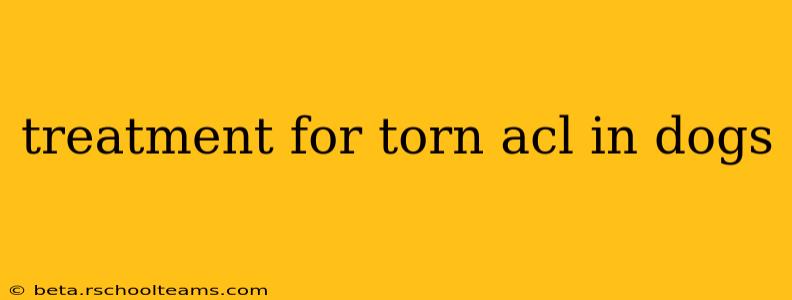A torn Anterior Cruciate Ligament (ACL), also known as a cranial cruciate ligament (CCL) rupture, is a common and debilitating injury in dogs, particularly larger breeds. Understanding the various treatment options is crucial for pet owners facing this diagnosis. This comprehensive guide explores the different approaches, helping you make informed decisions for your canine companion.
What is a Torn ACL in Dogs?
The ACL is a crucial ligament in the knee joint, providing stability and preventing the tibia (shinbone) from sliding forward relative to the femur (thighbone). When this ligament tears, it results in instability, pain, and lameness. The severity of the tear can range from a partial tear to a complete rupture. Breeds predisposed to ACL tears include Labrador Retrievers, Golden Retrievers, Rottweilers, and larger breeds.
What are the Symptoms of a Torn ACL in Dogs?
Recognizing the symptoms of a torn ACL is vital for early intervention. Common signs include:
- Sudden lameness: Often occurring after a minor injury or seemingly without cause.
- Limping or limping on three legs: The affected leg is usually held up or only partially weight-bearing.
- Swelling: Noticeable swelling around the knee joint.
- Pain: The dog may show signs of pain when the knee is touched or manipulated.
- Stiffness: Difficulty in bending or extending the knee.
- Muscle atrophy: Over time, the muscles around the affected leg may waste away due to disuse.
How is a Torn ACL in Dogs Diagnosed?
Veterinarians typically diagnose a torn ACL through a combination of physical examination and imaging techniques. The physical exam involves assessing the range of motion, stability, and pain response in the knee joint. Imaging techniques include:
- X-rays: While not directly visualizing the ligament, X-rays can rule out other injuries and assess for secondary osteoarthritis.
- Ultrasound: Can sometimes visualize the ligament and assess the extent of the tear.
- MRI: Provides the most detailed images of the ligament and surrounding structures, confirming the diagnosis and ruling out other potential issues.
What are the Treatment Options for a Torn ACL in Dogs?
Treatment options for a torn ACL in dogs vary depending on several factors, including the dog's size, age, activity level, and the severity of the tear. They generally fall into two categories: conservative and surgical.
Conservative Treatment (Non-Surgical):
Conservative management may be considered for smaller dogs, older dogs, or those with less severe tears. It usually involves:
- Rest and confinement: Limiting activity to prevent further damage.
- Pain management: Medications like NSAIDs (non-steroidal anti-inflammatory drugs) to reduce pain and inflammation.
- Physical therapy: Exercises and therapies to improve range of motion and strengthen muscles.
- Weight management: Maintaining a healthy weight reduces stress on the joint.
- Supportive bandages: Braces or bandages may provide some stability.
Surgical Treatment:
Surgical intervention is often recommended for larger breeds, more active dogs, or cases with complete ligament tears. Several surgical techniques exist, including:
- Tibial Plateau Leveling Osteotomy (TPLO): This procedure changes the angle of the tibia, reducing the forces on the knee joint and stabilizing it.
- Tibial Tuberosity Advancement (TTA): This procedure moves the tibial tuberosity, altering the pull of the quadriceps muscle and stabilizing the joint.
- Extracapsular repair: This involves using sutures or other implants to stabilize the joint externally.
The choice of surgical technique depends on various factors and is best determined by your veterinarian in consultation with a veterinary surgeon.
What is the Recovery Time After ACL Surgery in Dogs?
Post-operative recovery varies depending on the surgical procedure, the dog's size and overall health, and adherence to the veterinarian's instructions. Recovery typically involves strict rest and confinement for several weeks, followed by a gradual return to activity. Physical therapy is often recommended to help restore range of motion and strengthen muscles. Full recovery can take several months.
What is the Cost of ACL Surgery for Dogs?
The cost of ACL surgery for dogs can vary significantly depending on the surgical technique used, the veterinarian's fees, and other associated costs such as hospitalization, medications, and physical therapy. It's essential to discuss the costs with your veterinarian upfront.
How Can I Prevent a Torn ACL in Dogs?
While not always preventable, some strategies can help reduce the risk of a torn ACL:
- Maintain a healthy weight: Obesity puts extra stress on the joints.
- Controlled exercise: Avoid strenuous activities, especially on uneven surfaces.
- Proper conditioning: Gradual introduction of exercise and appropriate muscle strengthening.
This information is for general knowledge and does not constitute veterinary advice. Always consult with your veterinarian for diagnosis and treatment of any medical condition in your dog. They can assess your dog's specific situation and recommend the best course of action.
